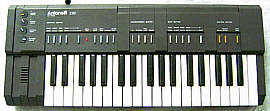 |
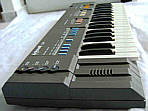 |
| Antonelli 2381 | analogue keyboard with cute accompaniments & arpeggios |
This analogue keyboard has nice sounding accompaniment with unusual, complex arpeggio and a trio sound effect that makes a lovely pop organ sound. The accompaniment has only single finger chord but responds so rapidly that it even accepts trilled notes.
 |
 |
This instrument was also released in a different case as Siel MK 370 (with slanted buttons and knob row, seen on eBay).
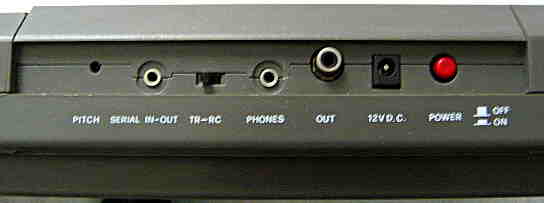 Instead of MIDI there is only a small serial port jack.
Instead of MIDI there is only a small serial port jack. |
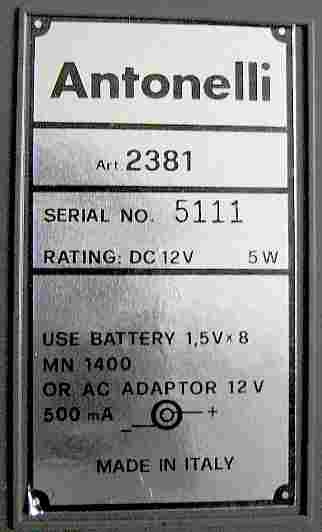 The
4 digit serial number 5111 hints that only quite small quantities of this
instrument were built. The
4 digit serial number 5111 hints that only quite small quantities of this
instrument were built. |
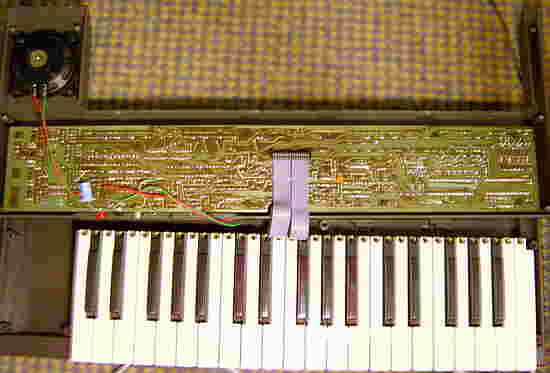 |
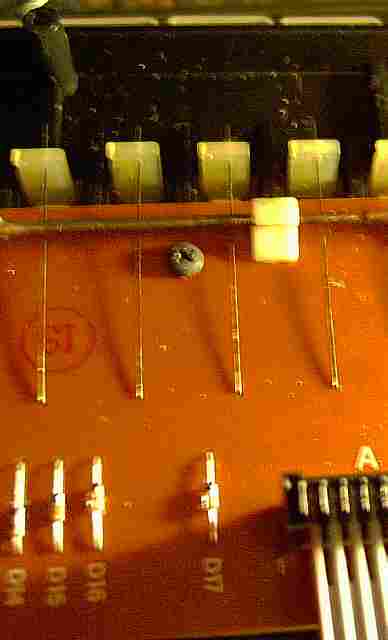 When
I got this instrument, all switches and keys made bad contact. The button
switches just needed a round of "Decathlon" played on them to make them
work. The key contacts have no silicone switches but metal spring wires(!)
those had to be treated with sand paper to make them work again. Remember
- this is not any 1970th home organ but a keyboard with PC output jack
that was still offered in the 1988(!) German Conrad Elektronik catalogue
although the hardware concept of this bizarre retro thing can be compared
best with a Yamaha PS-2 from 1980.
When
I got this instrument, all switches and keys made bad contact. The button
switches just needed a round of "Decathlon" played on them to make them
work. The key contacts have no silicone switches but metal spring wires(!)
those had to be treated with sand paper to make them work again. Remember
- this is not any 1970th home organ but a keyboard with PC output jack
that was still offered in the 1988(!) German Conrad Elektronik catalogue
although the hardware concept of this bizarre retro thing can be compared
best with a Yamaha PS-2 from 1980.
The case design is unusual but not really pretty; it even proudly shows a label "L/O DESIGN" despite this grey block with its many steps and slanted corners looks rather like inspired by certain awfully inhumane, bulky concrete block architecture from 1970th, which itself looked like inspired by car motor parts or the like. At least the thing has character, but especially the slightly sharp- edged stylish knobs are unergonomical to use. (They at least should have rubber rims instead of smooth plastic.) The speaker hole is quite small, but possibly this was even intended to make the sound of the cheap 8cm plastic speaker less hissy. The PCB contains quite much analogue stuff and has 2 trimmers for vibrato depth and percussion noise volume. (I haven't examined the hardware closer yet.) Almost all buttons are mechanically locking switches (even the demo button!).
The preset sounds are made by the Polyphonic Sound Generator IC "SGS M112B1", which in its datasheet is described as a drawbar organ on a chip. It has 7 drawbars of 32 step resolution, those each can use or bypass the ADSR volume envelope in various ways, and the IC even permits some external analogue controls. The timbres sound like made from multipulse squarewave; in fact they are made from up to 7 layered plain squarewaves (each using or bypassing the ADSR envelope). The "piano" sounds a little thin and more like an acoustic guitar. The "violin" has a vibrato and sounds quite realistic. The "brass" seems to be just a differently filtered version of the same timbre; it is hollower and duller and should be rather called oboe (or cello?). The "clarinet" sounds quite realistic, although a little hollow in the bass range. Also the "harpsichord" sounds ok. The "celesta" otherwise is no remotely what it is expected to be. It is a sonorous multipulse timbre that sounds rather like a pipe organ with vibrato and sustain. Perhaps it was intended as a vibraphone but has a way to long attack phase (like a pipe organ) for this. Perhaps they also wanted to imitate a bowed glass harp, but the timbre is wrong for this. The sound also has similarities with "fantasy" on Casio VL-Tone 1, although it is less creaky. The "organ 1" is a "black" droning pipe organ imitation based on the typical sonorous multipulse waveform with mild distortion in the bass range. The "organ 2" sounds more like a dull reed organ. The sustain button prolongs the release phase of all preset sounds except "celesta", which already contains vibrato.
The analogue percussion sounds a little thin and not really spectacular. Interesting is that there is not only a fill-in button, but by pressing the "metronome" button the rhythm track can be at any time replaced with the metronome sound, which consists only of a knocking "woodblock" noise with a quiet base drum on the 1st step. Interesting is that when "start stop" and "synchro" is on but "memory" is off, the rhythm plays only so long any key in the accompaniment section is held down. It stops by releasing these keys and always restarts the pattern by pressing an accompaniment key. This way some weird breakbeat stuff can be played by trilling on the keys. By turning tempo way down, you can also abuse this mode to play only the monophonic bass tone of the accompaniment like a sort of key split. With the tempo knob the rhythm tempo can be set very high but not extremely low.
The accompaniment features unfortunately only single finger chord and no fingered chord mode, but at least it responds so rapidly that it even accepts trilled notes. The accompaniments consist of piano and bass notes. Without rhythm it plays squarewave organ chords with a fixed timbre. With the "variation" button you can switch for each rhythm between a simpler and a more complex accompaniment pattern (the latter usually featuring a walking bass). The "arpeggio" button uses one of the main voice channels to play an arpeggio with the current melody voice preset sound. But unlike many older instruments, with most rhythms this "arpeggio" plays not just the famous chinking up, down or up- down pattern, but an additional, partly quite complex accompaniment voice. Some of these patterns resemble nicely typical friendly C64 pop synth tunes. When tempo is set to the max, the accompaniment and arpeggio turns into a continuous purring - much like certain famous C64 SID sound effects. By pressing the "counter melody" button, the (now monophonic) melody voice is turned into a harmonic trio when a chord is played in the accompaniment section. (You can also mute the accompaniment volume for this.)
The demo melody plays "When the Saints Go Marching In" with swing rhythm and accompaniment. All other sounds depend on the currently pressed buttons. The tune begins with a normal version that is followed by a nicely jazzy improvisation and then starts again until the locking demo button is released.
I don't know what the "serial" jack at the back of the instrument shall do. I read in the catalogue that it could be connected to the RS232 port of a PC (sort-of MIDI predecessor), but I have neither software nor a cable for this. At the back is also a "TR-RC" switch which may mean "transmit/ receive" to switch between data input and output. (Does anybody know more about this?)
I never saw improved variants of Antonelli 2381, but a more complex (and complicated) successor with same main voice sound IC and MIDI was the awesome Madison OK 500. A simpler successor (with MIDI and PCM main voices, but still analogue drums) was the Antonelli 2495 (49 fullsize keys) and its 41 key version Antonelli 2416. Both were also sold in 1988, but they have no OBS buttons anymore, the accompaniment patterns and everything else is more boring (even the identical demo tune lacks now the jazzy intermezzo) and their sound has a different character. A simplified variant of the 2381 hardware (without CPU, made in 1985) was used in the external sound card Siel - Sound Buggy for Commodore C64.
Wanted: I am searching for the historical
PC connection software (DOS drivers?) that came with or was sold for the
Antonelli
2381 keyboard. Does anybody has this software (original or copy) or
the special cable or at least some info about these?
| removal of these screws voids warranty... | ||
 |
||
|
|